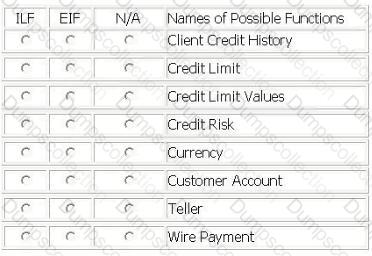IFPUG Certified Function Point Specialist I40-420 Exam Dumps: Updated Questions & Answers (December 2025)
PAYROLL APPLICATION - MAINTAIN EMPLOYEE TIME SCREEN
Employees can Add or Update their weekly hours information by entering the project and absence data on the Maintain Employee Time screen. Data is saved to the Employee Payroll ILF.
To begin the Add or Update from the Maintain Employee Time screen, the employee enters his/her employee badge number presses the Retrieve button. Retrieve will fill in the employee name and supervisor badge number from the Employee Master ILF, and will display the current pay period start date and end date from the Payroll Master ILF.
Employees can Delete existing weekly hours information by entering his/her employee badge number and pressing the delete button on the Maintain Employee Time screen. When the employee presses the delete button the current pay period hours will be removed from the Employee Payroll ILF.
PAYROLL APPLICATION - EMPLOYEE PROJECT ACTIVITY REPORT
The Employee Project Activity report is produced for each employee and routed electronically to that employee's email address. Each employee's project task hours for the current pay period are read from the Employee Payroll ILF. The report calculates and displays both daily and weekly total hours for the current pay period.
From the Names of Possible Functions listed identify the transactional functions for the Payroll application. Select N/A if a Name of Possible Functions does not apply.
Identify the functions used.
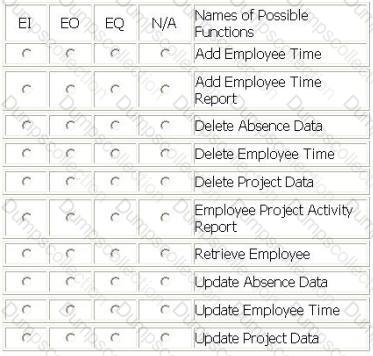
A Call Center (CC) application is being enhanced to track two new pieces of Information. The CC will reference the two new DETs in five modified data functions.
Productlogical file prior to the enhancement had 2 RETs and 25 DETs, the CC application had previously referenced 12 of those DETs.
Literaturelogical file previously referenced 5 RETs and 19 DETs. The two new DETs are being added to another RET NOT previously referenced.
Call Log logical file prior to the enhancement had 2 RETs and 19 DETs, the CC previously referenced all the DETs.
Customerlogical file prior to the enhancement had 1 RET and 36 DETs, the CC previously referenced only 25 of the DETs.
Contactlogical file prior to the enhancement had 1 RET and 68 DETs, the CC previously referenced all DETs.
Determine the complexity of the following functions:
Select the complexity for each function:
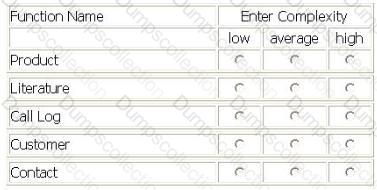
The Account Reconciliation Application (ARA) is used by banking operations to match credit (in) and debit (out) transactions within client accounts. Both credit and debit transactions are received from several other applications and stored as the Client Reconciliation logical file. ARA is capable of automatically matching transactions based on the Business Parameters logical file which is maintained by users in the ARA.
Access permissions in the User Access logical file are maintained by users in the ARA, and contain online user account permissions and approval levels.
The users can maintain their own report forms in the Reporting logical file. All reports use the Currency logical file, which is maintained by an external application, to convert the local payment currency to Euros.
From the Names of Possible Functions listed identify the data functions for the ARA. Select N/A if a Name of Possible Function does not apply.
Identify the functions used:
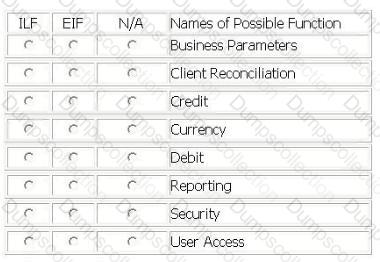
The Human Resources (HR) application contains 5 data functions.

Determine the complexity of data functions:
Select the complexity for each function:
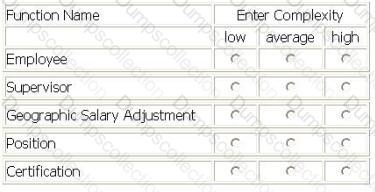
ITEM CHECK-OUT SCREEN
Library employees use the Item Check-Out screen when a member is ready check out the book(s) and/or magazine(s) he wishes to borrow. The library employee enters the member id number, and when the employee exits the member id attribute, if the member id is valid, the member name is retrieved from the Member Information logical file and displayed in the member name attribute. The library employee enters the item type (b for book, m for magazine) and the item code; the item title is retrieved from the Book Information logical file and displayed in the item title attribute. The library employee then enters the lending date and the due date, and presses the Add button. The information is stored in the Check-Out logical file.
Library employees use the Item Check-Out screen to update the due date of a book or magazine if a member requests additional lending time. The employee enters the member id number, and when the employee exits the member id attribute, if the member id is valid, the member name is retrieved from the Member Information logical file and displayed in the member name attribute, the library employee enters the item type (b for book, m for magazine) and the item code; the item title is retrieved from the Book Information logical file and displayed in the item title attribute and the lending date and due date are retrieved from the Check-Out logical file. The library employee then updates the due date, and presses the Update button. The new due date is stored in the Check-Out logical file.
The head librarian receives two reports from the Library Check-Out application. The first report is the Overdue Report which is a list of overdue items categorized into < 30 days overdue, 30 - 90 days overdue and > 90 days overdue.
The second report is the Low Usage Report that calculates which fiction books have not been checked out in the last 24 months and lists the title of those books. This report is run on demand. A High Usage Report with the number of times an item has been checked out has been put on hold and will not be released.
A proposed Member Check-Out Report with a list of books checked-out and recommended titles will not be developed until privacy issues have been resolved.
From the Names of Possible Functions listed identify the transactional functions for the current Library Check-Out application. Select N/A if a Name of Possible Function does not apply.
Identify the functions used:
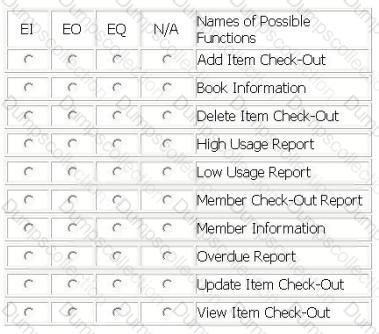
TAX APPLICATION
For the TAX application the user required the migration of existing taxpayer information (name, tax identification number, location name) to the TAX application. A conversion file with taxpayer data was created and imported into the Taxpayer logical file in the TAX application. The source of the data was the Account Holder logical file.
The user required the ability to Add, Change and Delete the taxpayer information in the Taxpayer logical file.
The user required the ability to View the taxpayer information prior to changing or deleting information.
From the Names of Possible Functions listed identify the base functional components for the TAX application baseline. Select N/A if a Name of Possible Functions does not apply.
Identify the functions used:
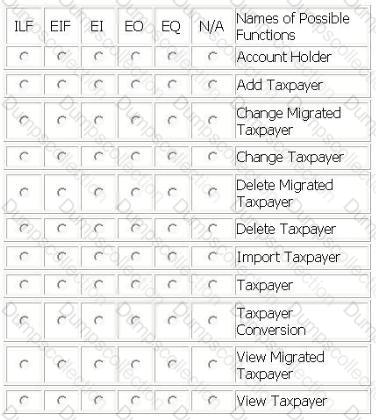
An Assets Tracking application has a batch update process. Twice a month each of the branch offices sends a transaction file to the headquarters.
Records are flagged with an "A" for equipment that is Added to the inventory; "C" for equipment that has been Upgraded or refurbished; "D" for equipment that has been Disposed of and is to be removed from inventory.
A summary inventory update report will be created that totals number of inventory records added, changed and deleted broken out by equipment type. The report will be sorted by branch and will start on a new page for each change of branch.
A detail inventory report will be available to the branches with the detail of inventory records updated.
From the Names of Possible Functions listed identify the transactional functions for the Assets Tracking application. Select N/A if a Name of Possible Functions does not apply.
Identify the functions used.
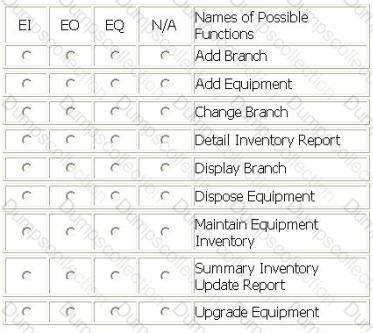
Data used by the Payroll Activity application is organized in the following logical groups:
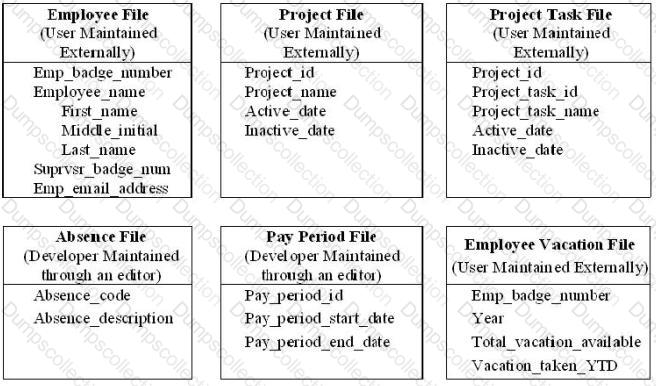
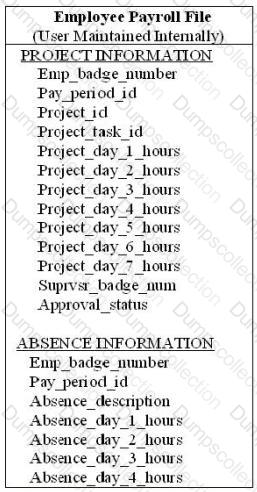
The Absence file and Pay Period file were implemented as part of the technical solution to facilitate business transactions.
From the Names of Possible Functions listed identify the data functions for the Payroll Activity application. Select N/A if a Name of Possible Function does not apply.
Identify the data functions used:
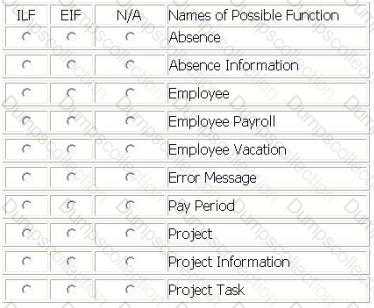
A Corporate Finance application is being developed.
The application adds or updates the Receivable logical file and the Payable logical file. The user requires that this information is sent to the Accounts application to keep accounting records consistent. The combined receivable and payable data is sent to the Accounts application daily at 8:00 PM.
When implementing a solution to send the receivable and payable information, it was decided to include a header and trailer record with the accounts information. These records are used by the Corporate Finance user to ensure that everything was technically correct when transmitting the file.
From the Names of Possible Functions listed identify the transactional functions for the Corporate Finance application. Select N/A if a Name of Possible Function does not apply.
Identify the functions used:
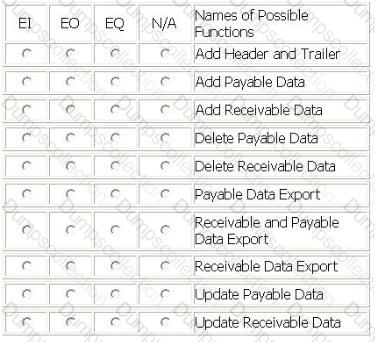
A baseline count is to be conducted for the Payment Information Application (PIA).
Client Credit History logical file is made available to the teller while processing a customer's wire payment. The Client Credit History logical file is retrieved from the Credit Master Application (CMA).
PIA also receives an end-of-day import file of wire payments from the Foreign Banking (FB) application. PIA maintains all customer wire payments in the Wire Payment logical file. During the processing of the wire payments, the currency is converted from the customer's local currency to PIA's currency using the FB application Currency logical file.
The teller must review the client credit history, and then update the Credit Limit logical file in the PIA before processing the wire payment.
Tellers maintain the Customer Account logical file using the maintain customer account function within PIA.
From the Names of Possible Functions listed identify the data functions for the PIA. Select N/A if a Name of Possible Function does not apply.
Identify the data functions used:
